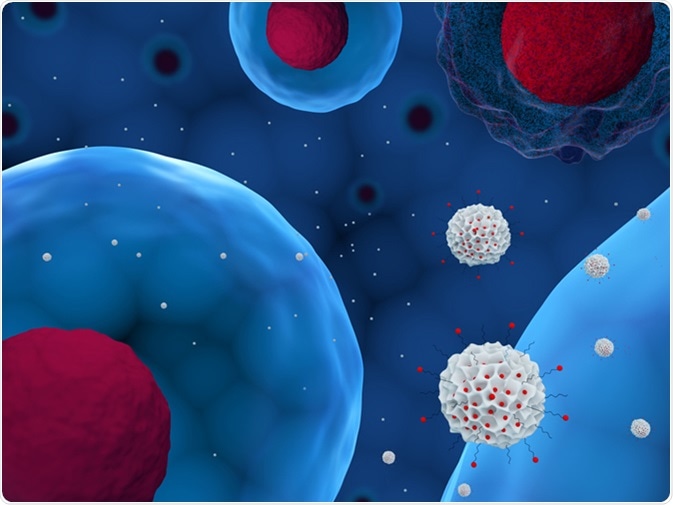Targeted drug delivery leads to more efficient dosage at the desired site. Nanomaterials have a size range in the nanometer range, which is a billionth of a meter. This is a good size for carrying drugs to target cells, as they are small enough to be able to enter these cells.

3d illustration of mesoporous silica nanoparticles delivering drug to cells. Image Credit: Meletios Verras / Shutterstock
Active Nanotargeting of Drugs
Nanomaterials are often targeted to specific regions in the body, such as tumors. This method can be applied for tumors as the nanoparticles can circulate in the blood stream for long periods, and they selectively accumulate in tumors.
Studies have also shown that nanoparticles can accumulate at the site of tumor even in the absence of a target ligand. However, in other cases nanoparticles with targeting ligands are created to specifically deliver the drug to a specific location in an active manner.
Passive Targeting of Nanodrugs
While active targeting uses molecules which interact with the target region, passive delivery system is independent of such mechanisms. In this case, the delivery is based on the Enhanced Permeability and Retention effect, or EPR, where the nanoparticles specifically accumulate in certain regions based on its size.
In this method, larger particles are more likely to be retained compared to the smaller particles, as smaller particles easily diffuse back into the vascular system. Passive targeting also requires a higher concentration gradient as the particles need to be in circulation for at least six hours.
Fate of Delivered Nanoparticles
Clearance
The targeted nanoparticles should have a long circulation period, but they also need to be cleared from the cells after a suitable amount of time. If these nanoparticles accumulate inside the cells it could affect other biological processes, leading to undesired effects. The removal of particles is done by the kidneys and opsonization.
Particles which are less than 5-6 nanometers (nm) are cleared and excreted from the bloodstream, whereas larger particles need to be removed by the reticuloendothelial system. To reduce opsonization, both size and the charge of the nanoparticles can be modified; smaller particles tend to be in the blood stream for longer durations.
Clearance rate is also dependent on the functions of the nanoparticles. For example, in case of therapeutic applications, the half-life should be longer for the particles to be in circulation for longer times. In case of applications such as image contrast agent, shorter half-life may be desirable.
Biodistribution
The factors which affect the biodistribution of nanoparticles are as follows: initial dose, method of administration, experimental model, and the time frame in which the experiment is performed. Several techniques are used to measure the biodistribution of nanoparticles, including CT, fluorescence imaging, MRI, autoradiography and magnetometer.
One of the critical factors for biodistribution is the size of the naonparticles, where smaller gold nanoparticles were present in larger numbers in tissues compared to larger particles. Shape is also another factor, where a recent study by Park and co. found that elongated nanoparticles accumulated in greater numbers in the tumor compared to spherical nanoparticles.
Nanoparticle drug delivery in cancer therapy
Release of Therapeutic from the Nanodelivery System
Once the nanodelivery system reaches the target site, the drug carried within the system needs to be released. The nanodelivery system should ensure that the drug is maintained in a stable state, and it should be compatible with the drug. The nanodelivery systems comprise of three groups: self-assembled carriers, including micelles, liposomes, and polymersomes; biodegradable polymer nanoparticles; and cross-linked systems.
Self-assembled naondelivery systems
These nanoparticles include liposomes, micelles and polymersomes. Both hydrophobic and hydrophilic drugs can be loaded on to this system. Lipophilic drugs are added to the inner aqueous void, while the hydrophobic molecules are added to the lipid bilayer.
Biodegradable nanodelivery systems
These nanoparticle delivery systems are made from emulsion and solvent evaporation methods. Hydrophobic drugs, including anti-cancer therapeutics are incorporated using this method.
Nanogels – an example of a cross-linked nanodelivery system
Nanogels include hydrophilic cross-linked networks which are insoluble in aqueous medium. They comprise a class of carriers called “smart delivery system”. They can swell in aqueous medium and respond to several stimuli, such as pH, temperature, ionic strength and electric field by increasing or decreasing in volume.
Further Reading
Last Updated: Feb 26, 2019